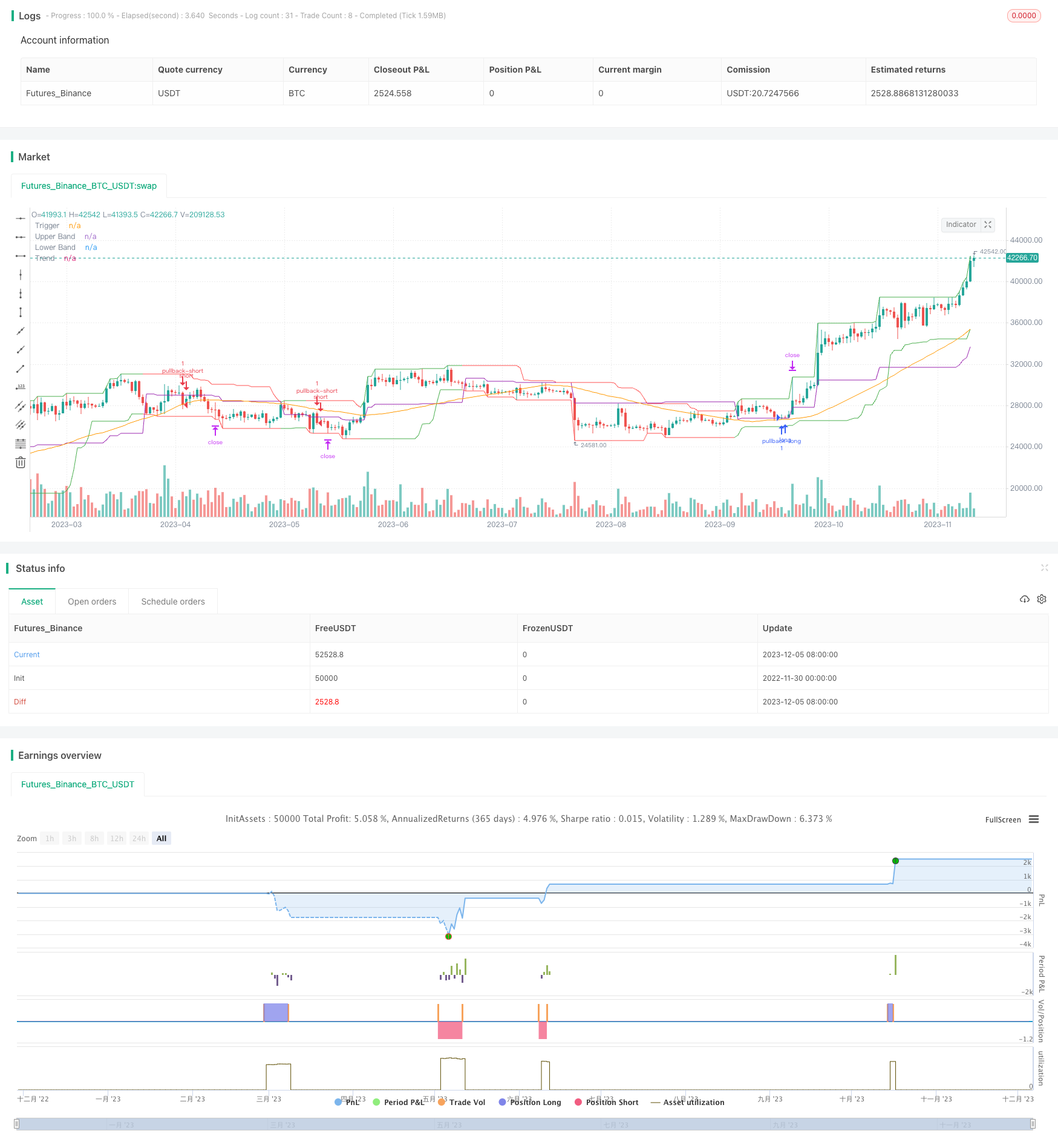黄金比率 平均逆転トレンド トレーディング戦略
作者: リン・ハーンチャオチャン, 日付: 2023-12-07 11:03:20タグ:

概要
ゴールデン比率平均逆転トレンドトレード戦略は,チャネル指標と移動平均を使用して,より強いトレンド方向を特定し,価格が一定の比率まで引き下がった後,トレンド方向のポジションを開く.この戦略は,より強いトレンド特性を有する市場に適しており,トレンド市場で良好なパフォーマンスを発揮することができます.
戦略の論理
この戦略の主な指標は,チャネル指標,移動平均値,リトルラインなどです.
- チャネル指標は,価格チャネルを特定するために,最高高値と最低低値から計算されます.
- 移動平均は,価格の全体的な傾向方向を決定するために使用されます.
- 引き戻しトリガーラインは,価格が特定の比率でチャネル境界から反転した後,ポジションを開きます.
価格がチャネルの底に触ると,戦略は最低点を基準点として記録し,セールシグナルを設定します.価格が上昇すると,上昇が引き戻し比に達すると,リバウンドポイントの周りにショートポジションが開かれます.
逆に,価格がチャネルの上位に達すると,戦略は最高点を基準点として記録し,購入信号を設定します.価格が下がると,引き下げ比率が要求される場合,その点の周りにロングポジションが開かれます.
したがって,この戦略の取引論理は,価格チャネルを追跡し,逆転信号が現れたときに既存のトレンドに介入することです.これは平均逆転トレンド取引戦略の一般的なルーチンに属します.
利点分析
この戦略の主な利点は以下の通りです.
- 強いトレンド市場では 良くなっています
- 引き戻し比パラメータによって取引への進出の積極性を調整できます.
- 合理的な引き上げ制御は,単一の取引損失を制限することができます.
特に,戦略は主にトレンド逆転点でポジションを開くため,価格変動が大きく,傾向がより明白な市場ではよりうまく機能します.また,プルバック比率パラメータを調整することで,トレンドに従う戦略の攻撃性のレベルを制御できます.最後に,ストップロスは単一のトレード損失を非常にうまく制御することができます.
リスク分析
この戦略の主なリスクには,以下も含まれます.
- この戦略は,取引手段の傾向特性に敏感です.
- 不適切な引き戻し比設定は,過度に攻撃的または過度に保守的になる可能性があります.
- ポジションを保持する時間が長すぎると 一夜間のリスクに注意を払う必要があります
特に,戦略で使用される取引手段が傾向が弱く変動が小さい場合,パフォーマンスが損なわれる可能性があります.また,過剰なまたは過小なプルバック比率は戦略のパフォーマンスに影響します.最後に,戦略のポジション保持時間が長くなる可能性があるため,一夜間のリスク管理にも注意が必要です.
上記のリスクを避けるために,次の側面を最適化することを検討してください.
- 傾向の特徴がはっきりした取引手段を選択する.
- 最適なパラメータの組み合わせを見つけるために 引き戻し比パラメータを調整します
- 保持時間を合理的に制御するために利益を取出を設定します.
結論
金比平均逆転傾向トレード戦略は,単純な指標を通じて価格動向と引き下げ信号を判断し,強い市場の動向を追跡するためにポジションを開き,典型的なトレンドシステムに属しています.この戦略は,大きなパラメータ調整スペースを持ち,最適化を通じてより多くの市場環境に適応することができ,リスク管理も合理的です.したがって,ライブ取引で検証し改善する価値のある戦略アイデアです.
/*backtest
start: 2022-11-30 00:00:00
end: 2023-12-06 00:00:00
period: 1d
basePeriod: 1h
exchanges: [{"eid":"Futures_Binance","currency":"BTC_USDT"}]
*/
//@version=3
//
// A port of the TradeStation EasyLanguage code for a mean-revision strategy described at
// http://traders.com/Documentation/FEEDbk_docs/2017/01/TradersTips.html
//
// "In “Mean-Reversion Swing Trading,” which appeared in the December 2016 issue of STOCKS & COMMODITIES, author Ken Calhoun
// describes a trading methodology where the trader attempts to enter an existing trend after there has been a pullback.
// He suggests looking for 50% pullbacks in strong trends and waiting for price to move back in the direction of the trend
// before entering the trade."
//
// See Also:
// - 9 Mistakes Quants Make that Cause Backtests to Lie (https://blog.quantopian.com/9-mistakes-quants-make-that-cause-backtests-to-lie-by-tucker-balch-ph-d/)
// - When Backtests Meet Reality (http://financial-hacker.com/Backtest.pdf)
// - Why MT4 backtesting does not work (http://www.stevehopwoodforex.com/phpBB3/viewtopic.php?f=28&t=4020)
//
//
// -----------------------------------------------------------------------------
// Copyright 2018 sherwind
//
// This program is free software: you can redistribute it and/or modify
// it under the terms of the GNU General Public License as published by
// the Free Software Foundation, either version 3 of the License, or
// any later version.
//
// This program is distributed in the hope that it will be useful,
// but WITHOUT ANY WARRANTY; without even the implied warranty of
// MERCHANTABILITY or FITNESS FOR A PARTICULAR PURPOSE. See the
// GNU General Public License for more details.
//
// The GNU General Public License can be found here
// <http://www.gnu.org/licenses/>.
//
// -----------------------------------------------------------------------------
//
strategy("Mean-Reversion Swing Trading Strategy v1", shorttitle="MRST Strategy v1", overlay=true)
channel_len = input(defval=20, title="Channel Period", minval=1)
pullback_pct = input(defval=0.5, title="Percent Pull Back Trigger", minval=0.01, maxval=1, step=0.01)
trend_filter_len = input(defval=50, title="Trend MA Period", minval=1)
upper_band = highest(high, channel_len)
lower_band = lowest(low, channel_len)
trend = sma(close, trend_filter_len)
low_ref = 0.0
low_ref := nz(low_ref[1])
high_ref = 0.0
high_ref := nz(high_ref[1])
long_ok = false
long_ok := nz(long_ok[1])
short_ok = false
short_ok := nz(short_ok[1])
long_ok2 = false
long_ok2 := nz(long_ok2[1])
if (low == lower_band)
low_ref := low
long_ok := false
short_ok := true
long_ok2 := false
if (high == upper_band)
high_ref := high
long_ok := true
short_ok := false
long_ok2 := true
// Pull Back Level
trigger = long_ok2 ? high_ref - pullback_pct * (high_ref - low_ref) : low_ref + pullback_pct * (high_ref - low_ref)
plot(upper_band, title="Upper Band", color=long_ok2?green:red)
plot(lower_band, title="Lower Band", color=long_ok2?green:red)
plot(trigger, title="Trigger", color=purple)
plot(trend, title="Trend", color=orange)
enter_long = long_ok[1] and long_ok and crossover(close, trigger) and close > trend and strategy.position_size <= 0
enter_short = short_ok[1] and short_ok and crossunder(close, trigger) and close < trend and strategy.position_size >= 0
if (enter_long)
long_ok := false
strategy.entry("pullback-long", strategy.long, stop=close, comment="pullback-long")
else
strategy.cancel("pullback-long")
if (enter_short)
short_ok := false
strategy.entry("pullback-short", strategy.short, stop=close, comment="pullback-short")
else
strategy.cancel("pullback-short")
strategy.exit("exit-long", "pullback-long", limit=upper_band, stop=lower_band)
strategy.exit("exit-short", "pullback-short", limit=lower_band, stop=upper_band)
- ダイナミック・モメント・戦略
- 複数の指標に基づいたジョンのビットコイン・イントラデイ・トレーディング戦略
- スロー・ムービング・平均戦略
- Zスコア価格ブレイク戦略
- フィボナッチリトレースメント逆転戦略
- 双要素量取引戦略
- 双 EMA ゴールデンクロス 取引戦略
- 移動平均のクロスオーバーに基づくBTC取引戦略
- MACD インディケーター ダウン逆転 早期警告 戦略
- マラの適応型移動平均戦略
- 複数の移動平均値に基づくトレンド取引戦略
- 二重インジケーターフィルタリング 購入シグナル戦略
- 2つの移動平均のクロスオーバー取引戦略
- 双重EMAクロスオーバー戦略
- モメントブレイク カマリラ支援戦略
- ハニー・トレンド ATR ブレイクアウト戦略
- EMA と の 戦略 を フォロー する トレンド
- 2回逆転 % 変化バー 定量戦略
- MA トレンドフィルターによるボリンジャー・バンド逆転
- RSIに基づく定量的な取引戦略